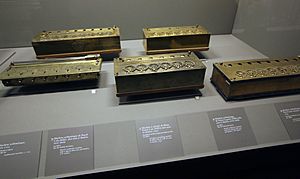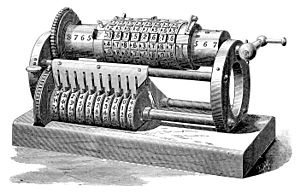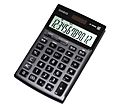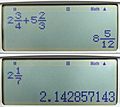Calculator facts for kids
A calculator is a machine that helps people do math problems easily. Most calculators can add, subtract, multiply, and divide. Some can also find square roots. More advanced calculators can even help with calculus and draw graphs.
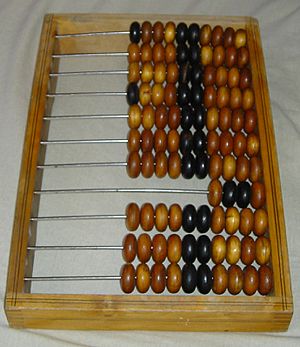
Calculators are everywhere! Your smartphone or computer can also work as a calculator. Some calculators, like the abacus, don't need batteries. Others, like electronic calculators, do.
There are two main types of electronic calculators:
- Simple calculators can only add, subtract, multiply, divide, and sometimes find square roots.
- Scientific calculators can do many more things, like calculate factorials and trigonometry problems.
You can enter math problems in different ways on a calculator. For example, to add 3 and 2, you might press "3", then "+", then "2", then "=". The answer "5" will show up. This is called infix notation. Many advanced calculators use postfix notation, where you would type "3 4 +" for "3 + 4". A third way, "+ 3 4", called prefix notation, is rarely used on calculators.
Contents
How Calculators Began
The first tools to help with math were very simple. People used bones to count things. They also used pebbles and counting boards. The abacus was used by people in Sumer and Egypt before 2000 BC.
Around the 1600s, new tools started to appear. Galileo made the geometric-military compass. Napier invented logarithms and Napier's bones. The slide rule was also invented around this time.
In 1642, the mechanical calculator was invented. Wilhelm Schickard and Blaise Pascal created machines that could add and subtract. Pascal's machine could also multiply and divide by repeating additions. Schickard's machine used special parts to help with multiplication and division. Later, Gottfried Leibniz spent many years trying to build a calculator that could do all four math operations. He invented the leibniz wheel.
In the 18th century, Giovanni Poleni made a working calculating clock. But these machines were often one-of-a-kind. Real progress happened in the 19th century, during the Industrial Revolution. Better ways of making things allowed for more modern and smaller calculators.
The Arithmometer was invented in 1820. It became the first successful calculator sold to many people starting in 1851. By 1890, thousands of these machines were sold. The familiar push-button design we see today came out in 1902 with the Dalton Adding Machine.
The Curta calculator was made in 1948. It was expensive but popular because it was small enough to carry. This mechanical device could add, subtract, multiply, and divide. By the early 1970s, electronic pocket calculators took over. The Curta is now a popular item for collectors.
What is a Pocket Calculator?
A pocket calculator is a small device that helps people do arithmetic. It is small enough to fit in your pocket. Most pocket calculators are used for addition, subtraction, multiplication, and division. Many of them get their power from solar cells. They are often used in schools and businesses for quick and easy math problems.
What Can a Scientific Calculator Do?
A scientific calculator can do many more things than a simple one. It can work with exponents, pi, trigonometric ratios, and follow the order of operations. Scientific calculators can also handle much bigger numbers. They usually cost more than simple pocket calculators. Most scientific calculators can be programmed. This means you can create a program directly on the calculator or send one from a computer.
Calculators in School
In many countries, students use calculators for schoolwork. At first, some people worried that using calculators would make students less skilled at basic math. There is still some debate about how important it is to do math problems in your head.
Some schools limit when students can use calculators until they are good at basic math. Other schools focus more on teaching how to guess answers and solve problems. Studies suggest that if students don't learn how to use calculators properly, it might limit their math thinking. Some people also believe that using calculators too much can stop students from understanding advanced math ideas.
In 2011, a UK government official, Nick Gibb, said that children might become "too dependent" on calculators. Because of this, calculator use is being looked at as part of the school curriculum review. In the United States, many math teachers and school boards have supported using calculators in classrooms from kindergarten through high school.
More About Calculators
Images for kids
-
An electronic pocket calculator with a seven-segment liquid-crystal display (LCD) that can perform arithmetic operations
-
Early calculator light-emitting diode (LED) display from the 1970s (USSR)
-
The Elektronika MK-52 was a programmable RPN-style calculator that accepted extension modules; it was manufactured in the Soviet Union from 1985 to 1992
-
The interior of a Casio fx-20 scientific calculator from the mid-1970s, using a VFD. The processor integrated circuit (IC) is made by NEC (marked μPD978C). Discrete electronic components like capacitors and resistors and the IC are mounted on a printed circuit board (PCB). This calculator uses a battery pack as a power source.
-
Inside a Casio scientific calculator from the mid-1990s, showing the processor chip (small square; top-middle; left), keypad contacts, right (with matching contacts on the left), the back of the LCD (top; marked 4L102E), battery compartment, and other components. The solar cell assembly is under the chip.
-
The interior of a newer (ca. 2000) pocket calculator. It uses a button battery in combination with a solar cell. The processor is a "Chip on Board" type, covered with dark epoxy.
See also
 In Spanish: Calculadora para niños
In Spanish: Calculadora para niños



